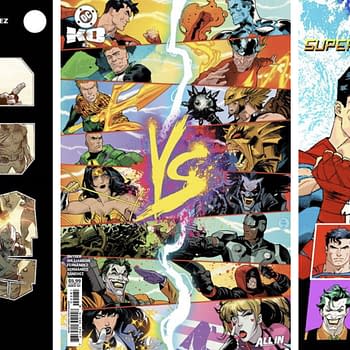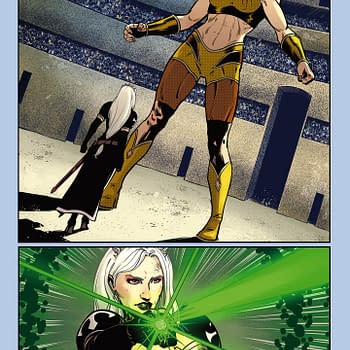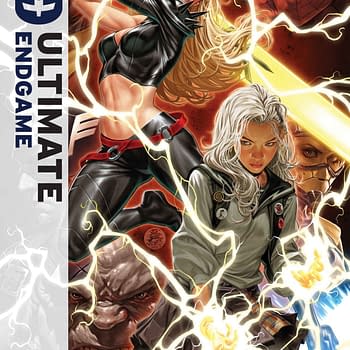Posted in: Comics, Recent Updates | Tagged: Comics, grant morrison
Grant Morrison Under the Microscope

Despite sequential art having been around for over a 100 years it's only in the last 5-6 years that universities and academics in the UK have really been taking comics studies seriously and more and more scholarly events—like the one I just attended—have been happening. Last weekend I was in Dublin attending the Grant Morrison and The Superhero Renaissance conference. Suitably sounding like a Prince concert, the event was held in the very modern (and Swedish sauna feeling—lots of bare wood) Long Room Hub of Trinity College.
"the world is made of words […] if you know the words that the world is made of you canmake of it whatever you wish."– Terence McKenna, Alien Dreamtime"You'll have to excuse me…I've been trying to learn an alien language and it all came back up."– Helga, The InvisiblesThe sheer variety of the Morrison canon can astound a reader; how can such diverse work spring from a single writer? Is he, like the Joker of Arkham Asylum, 'a brilliant new modification of human perception […] He has no real personality. He creates himself each day.'? My reading of Morrison will be informed by memetics, semiotics, and one of the works cited as influencing The Invisibles: Michel Bertiaux's Voudon Gnostic Workbook. Why choose this work over any of the dozens of other texts Morrison has acknowledged as inspirations? Like Morrison's work, Bertiaux's is synthetic, a combination of apparently unrelated material leading to a new model of the world. As with voudon/voodoo, Morrison presents a vision of multiple universes, literal and fictional, where travel from one realm to another is both possession and the adoption of a persona. Finally, Morrison is a profoundly Gnostic writer, repeatedly dramatising paradigm shift or conceptual breakthrough. An intellectual cartographer, his maps are constructed through language and meta-language; this paper will investigate the nature of these constructions, and the web of connections between words and worlds in Morrison's work.
'Nothing is so great which a marvelous genius, prompted by his laudable zeal, is not able to lessen.'– Alexander Pope, 'Peri Bathous, or, The Art of Sinking in Poetry' (1727)Pope introduced the literary world to the term 'bathos' in an attempt to shame the poetical bunglers of his day, yet bathos has become more than an accident of style. Used consciously by a writer, it can serve as a means to test readers' expectations and expand the limits of genre.This paper examines key examples of bathos in Morrison's writing, reflecting upon how he achieves the effect and what purpose it serves in his works. It initially focusses on the early serials for DC Comics (Animal Man, Doom Patrol), arguing that the 'downbeat' feel of these comics and their reliance on Dada and the absurd is indicative of Morrison's troubled relationship with post-Crisis continuity and editorial authority. A comparison is then made with more recent works (All-Star Superman, Batman RIP), where bathetic elements are seen to be less pervasive, yet individually crucial to the crafting of more hopeful and uplifting narratives. In moving towards a conclusion, the paper considers if Morrison's work constitutes a meaningful challenge to Pope's notion that bathos is antithetical to the artist's pursuit of 'the sublime'.
This lecture will explore the relationship between two key features of Grant Morrison's writing, the immersive strategies he employs to embed both his own persona (often in terms of an avatar) and an analogue for the reader in his comics, and the ways in which this is linked to recursive strategies. Recursion is a central motif of Morrison's work, with its emphasis on repetition and cyclical structures. The theory of recursion also touches upon several of Morrison's key themes and interests, including language (linguist Noam Chomsky believes it to be a defining aspect of human communication), fractal geometry (where recursive patterns dictate the development of non-Euclidean natural structures), and what the cognitive scientist Douglas Hofstadter refers to as "strange loops", whereby a return to origin is the end point in certain kinds of relations, and where hierarchy disappears and becomes "heterarchy". Many of Morrison's comics blend immersive strategies with recursive structures, and both are realised at the level of theme, and in the form of the comics themselves, on the one hand exploring notions of identity, storytelling, apocalypse and transcendence, but also tapping into the very fabric of communication and cognition. Morrison's comics integrate these concepts and themes in a dizzying roller-coaster ride of playful intertextuality, pop-magic and intellectual seriousness, making him one of the most fascinating authors working today.
The double identities of comic book superheroes are structured in such a way as to suggest that strength in the masculine public sphere is the truest sign of manhood. At its extreme, the hypermasculine superhero embodies a dominant masculinity armoured against any possible infection by the feminine, even if that means rejecting love, marriage, and the home. Yet, at the same time, this armoured self can be read as the expression of a sense of male shame and inadequacy, with the hero removing himself from the home because he cannot trust himself given the, often sexual, violence that defines him as a man.As early as 1993, Grant Morrison was concerned with "the idea of diffusing the hard body," the results of which are evident in Animal Man, Doom Patrol, and Flex Mentallo, for example. But it is in The Filth that he tries to show how, as he says, "the shabbiest, shittiest life you can live," one defined and limited by shame, guilty, fear, hatred, and loneliness, "can be redeemed into glory by the power of imagination." Here, the hero seemingly is Ned Slade, a high-ranking officer of the "supercleansing" operation The Hand, whose off-duty persona is Greg Feely, a single man, addicted to pornography and accused of paedophilia, but fiercely dedicated to his cat Tony's well-being. Shifting between worlds of differing scales and dimensions, The Filth, as its name suggests, studies the interactions of perversion and policing and, in the process, the superhero's part in redeeming male shame.In Animal Man, Grant Morrison meta-fictionally interrogates the comics art form by inserting himself into the narrative, and hence into DC continuity, interacting with his protagonist Animal Man in-panel and highlighting the complex relationship between creator and created. While Morrison's role as the writer of Animal Man ('the writer' as creator) has been a focus of attention in comics studies, his fictional role as the Writer in DC continuity ('the Writer' as character) has been less well examined. I shall focus on the Writer's only other appearance: Suicide Squad #58. In this issue the Writer can control events within the narrative by typing on his word processor. Although killed off by the writer of this comic, Joe Ostrander (providing a novel perspective on old debates about the 'death of the author') the Writer is, prior to his death, aware that his control over events is limited by the fact that he – that is, Grant Morrison – is now a character within DC comics continuity. As a result, Morrison (the writer) no longer has sole control over Morrison (the Writer), since other writers (e.g. Ostrander) can control the character in other comics. Hence, this issue of Suicide Squad forces us to re-conceptualize the relationships between the author as creator and the author as meta-fictional construct within his own creation, at least when this creation is a massively collaborative fictional universe like DC continuity.
In his treatment of the New Gods in Final Crisis, Grant Morrison richly weaves Platonic ideas into the DC Universe, from the Radion 'Essence of Bullet' that can kill gods to Darkseid's Hyper-Adapter, a living curse, a spoken idea given form in physical reality, to Darkseid himself, as the Hole In Things, comparable to the Neoplatonic conception of evil as a lacking of good. By making the Fourth World and its elements into a realm of Platonic Ideal Forms, Morrison gives a deeper meaning and an eternal hyper-significance to the events of Final Crisis and the following stories; furthermore, by thrusting Batman into this world and having him fatally wound a god and then travel from the distant past to the infinite future, Morrison makes his Batman an ever-present feature in the history of DC's Earth, essentially making him into an idea as essential to humanity as any other idea in the DC universe, and making him into a new god, an idea powerful enough to be pitted against the idea of crime itself in Batman, Incorporated. My paper will trace the roots of the evil gods of Final Crisis to Neoplatonic sources in sources from the Late Antique and Renaissance flourishings of Platonic thought, including Plotinus, Apuleius, Augustine, Justin Martyr, Iamblichus, Marsilio Ficino, and Giovanni Pico. Further, I will explore how this use of Neoplatonic concepts broadens the DC Universe and adds to the story of DC's stories which is Final Crisis.
This paper draws on my recent monograph Hunting the Dark Knight: 21st Century Batman, which in turn builds on my previous book Batman Unmasked (Continuum, 2000) – based on my PhD into Batman's first sixty years – and my other published work such as 'The Best Batman Story' in Alan McKee's Beautiful Things in Popular Culture (Wiley-Blackwell, 2006), and 'Hero of the Beach', on Flex Mentallo, in The Journal of Comics and Graphic Novels (2011).It examines Grant Morrison's approach to Batman's history as 'as the events in one man's extraordinarily vivid life' and argues that Morrison's sustained run on the flagship titles, from Batman in 2006 through the stories of The Black Glove and Batman RIP to Batman Incorporated in 2011, subverted the normally-repressive rules of continuity by bringing long-forgotten stories – including science fiction, fantasy and camp – back into mainstream canon.Drawing on Mikhail Bakhtin's theory of carnival, the paper discusses the ways in which Morrison's portrayal of Batman embraced diversity and fragmentation, and captured a sense of Batman's prismatic, mosaic totality, for a brief period before the containment and reduction of the character's history in the New 52 reboot of October 2011.
This paper examines Morrison's recurrent themes of transgendered characters, transvestitism, in both his personal and creative life, and will focus on his concept of the "Liquid Personality." It will explore how many of Morrison's characters evolve, both physically, emotionally and psychically, and how the sense of "the self" is in fact a malleable form capable of being manipulated, either by internal or external forces. Works examined include Animal Man, Kill Your Boyfriend, The Mystery Play, The Filth, The Invisibles, Flex Mentallo, Doom Patrol and All Star Superman, amongst others. It will also examine how Morrison has taken these concepts and used them on himself, reinventing his public face to present different personalities to the world at large. From lonely, post-goth geek in Glasgow, through "angry young man of comics", to hip, counterculture L.A. guru to the stars. As Morrison himself has stated, "I use media exposure as a means of playing with multiple personalities. Each interview is a different me and they're all untrustworthy." The paper aims to peel away the masks of Morrison and his work.
Personally, I can't think of many comic book writers (apart from Alan Moore and Neil Gaiman) who could elicit this much attention and analysis from academics, and that alone speaks volumes.
And if you can't get enough Grant Morrison (and let's face it, who can?) he'll be at his own Morrisoncon in Las Vegas in 10 days time; then on 11-14 October he'll be appearing at the New York Comic Con; and finally, on 28 October, there's the Dundee Comics Day dedicated to Grant (organised by Chris Murray and the Dundee Uni crowd). Phew! He's like a media shark—he never stops moving forward!











